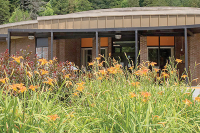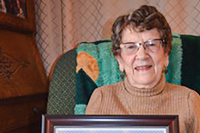Swain embarks on new vision for old library
More bestsellers? A computer lab? Meeting space?
This month, Swain County residents will be asked what it is they crave from their local Marianna Black Library. The surveys are part of an assessment funded by a planning grant from the State Library of North Carolina.
Jackson and Macon counties went through a similar visioning process — and in both cases it led to brand-new libraries.
At the top of librarian Jeff Delfield’s own list is simply more space. The Marianna Black Library is barely 8,000-square-feet when the state recommends about 20,000-square-feet for each county’s main library.
“I think we could at least double the space and not really be outrageous about it,” Delfield said.
Parking at the Bryson City library is so limited that would-be library patrons have to scour downtown for parking spots blocks away or simply come back another time.
Another deficiency is a section devoted solely to teens.
“Teens have nowhere to go in this library,” said Delfield.
Delfield points out that while Swain’s library is a fine one, it dates back four decades.
“Swain County has changed a lot in 40 years. We have, I think, doubled in population,” Delfield said. “Even if we could put another story on this building, that doesn’t solve our parking problem.”
Delfield admires neighboring Macon County’s spacious new library. It features a common area with a fireplace around which patrons gather with books and laptops. There are also plenty of small meeting rooms where students can get together to work on projects.
He said he can imagine something similar at the library in Bryson City for the future.
Another of Swain’s neighbors, Jackson County, is set to open a new 26,000-square-foot library of its own, far larger than its current 6,400-square-foot building.
Both Macon and Jackson county libraries utilized the help of Ron Dubberly, the consultant who will now tackle the library assessment in Swain.
Jackson County librarian Dottie Brunette said hiring Dubberly was helpful in coming up with a blueprint for the new library there. She estimated that about two-thirds of the plan for the library resulted from Duberly’s work.
“You have to know what your community wants before you can start doing those things,” Brunette said.
For instance, the Sylva community was adamant that the library’s location remain downtown, which eventully won out.
The process
Dubberly said most communities that go through the public assessment are eager to move forward with an expansion or a new building. Dubberly said the needs for space are obvious in Swain County, but the final say rests with the public.
“The first thing is you find out what the community’s needs are,” Dubberly said. “And you only know that truly by asking.”
Residents will be surveyed in early October to choose from a list of “service priorities” the library should provide. These priorities range from children’s story time to foreign language to genealogy materials.
Dubberly and library staff want to hear from people from Cherokee to the Nantahala Gorge and from Alarka to downtown Bryson City to come up with a library that will serve all.
“We want to reach people who don’t even come to the library,” Delfield said.
Dubberly will also meet with city and county officials, library board members, Friends of the Marianna Black Library and other stakeholders. He will analyze demographics and population projections before coming up with a draft plan for the library. Another public meeting will ensue before Dubberly presents the final plan to the library board and county commissioners.
The plan will address Swain’s needs for library services and also provide recommendations on space, furnishings, equipment, shelving, collection items and more.
Dubberly said even with all his experience, there’s no way to predict what Swain County residents will want from their public library.
“I just start fresh. I don’t have a cookie cutter,” Dubberly said. “Every community is unique.”
Want to weigh in?
Public input is needed to shape the future of the Swain County library, whether its an expanded children’s section, more DVD rentals or a brand-new library. Drop by one of the following sessions to share your ideas. For more information, call 828.488.3030.
Monday, October 11
• noon, Marianna Black Library
• 3 p.m. Qualla Public Library in Cherokee
• 5:30 p.m. Nantahala Village in the Gorge
Tuesday, October 12
• 10 a.m. Alarka Community Center
• 3 p.m. Bryson City Presbyterian Church
• 5:30 p.m. Marianna Black Library
• 7 p.m. Marianna Black Library
Wednesday, October 13
• 10 a.m. Swain Senior Center
Haywood budget cuts pose hardship for some library users
Kaleigh Davis, 12, comes to the Haywood County Public Library with her aunt Marlene Arrington almost every Thursday night. Arrington said the family can’t afford a computer at home so when Davis had to do a project that was a fifth grade requirement, the family depended on the library.
“There’s no way without the library that we could have done it,” Arrington said. “Thursday night is the only time I can come. I work during the day.”
Thursday is the only night of the week the library stays open past 6 p.m. But starting June 14, the Haywood County Public Library will terminate evening hours completely.
The four branches of the Haywood County Public Library system will see about a $60,600 cut in the county’s budget for the upcoming year, according to Julie Davis, Haywood County finance officer. That’s brings the libraries budget down more than 4 percent from last year’s $1.42 million.
This year’s library allotment is about $162,000 less than it was in the 2007-08 budget prior to the recession. “You’ve got to figure out how to keep the doors open and that’s what it comes down to,” County Library Director Robert Busko said. “It’s a big chunk of money to have to make up.”
To deal with the cuts, the Haywood libraries will restrict hours at some libraries, reduce the materials budget and cut one full-time position — the director of the Maggie Valley Branch who is retiring.
“It’s only one position, but it comes on the heels of last year when we lost two full-time and six part-time positions,” Busko said. That year, the county made budget cuts across all county departments in response to the recession.
Fines Creek Public Library will now be open Monday and Wednesday, and the Maggie Valley Public Library will be open on Tuesday and Thursday.
Both libraries were previously open Monday through Thursday.
No hours will be cut at the Canton Branch, which had to cut nine hours of service with last year’s budget cuts, said Nan Williamson, the director of the Canton Public Library.
“We are as skeleton as we can be in providing services to the public,” Williamson said.
Busko said part-time librarians helped cover schedule gaps created by the later night hours and staffers’ summer vacations, but after last year’s cuts, the library now only has one part-time staff member. The small crew makes it near impossible to cover shifts when employees take their vacation.
“My concern was getting into the summer season and getting in a position where we can’t cover the hours,” Busko said. “In my mind, we are going to reinstitute those (evening) hours in the fall.”
But given the lean staffing, a bad flu season or other unseen events could keep the library from having the staff to open the library on Thursday nights again in the fall, Busko said.
The evening hours are critical to some — whether its working parents with schoolchildren or those who simply can’t get away from their jobs during the day to check out a book or use the Internet.
But the library will keep its Saturday hours so those who are on the job during normal workweek hours will still have access.
Alan McRae from Canton is a computer consultant with a flexible schedule. The cuts in the Thursday hours won’t keep him from coming to the library. But McRae said he is concerned about the budget cuts to the libraries and fine arts in general.
“It’s a shame with our financial issues in the States that we have to cut back on all these things,” McRae said. “I hope we do come up with creative solutions to these problems.”
Busko said the library has examined the budget and cut where they could, but a lot of the budget is fixed. Certain line items such as utilities and the Internet can’t be cut, he said.
Last year, the Internet cost the library $10,000 more than anticipated, Busko said. In order to cover it, the library had to move money around from other areas in the budget.
“Right now, there’s no money to move around,” Busko said.
In case something like that happens again, Busko has cut excess money from the new materials budget to save up a reserve.
The total cut to new materials budget is $25,000, which affects the number of copies of new releases that the library can buy.
“Basically we will be working with a book budget that’s been the lowest it’s been in 15 years,” Williamson said, adding that book prices are also much higher than they used to be.
In the past, the library could buy nine or 10 copies of a popular new release. Now they can only afford five or six copies, Busko said. To make sure everyone still gets a chance to read the books, some of the most popular authors and books will have shorter circulation times.
“It inconveniences the reader because they don’t have three weeks to read it, but it insures that everyone gets a fair shot at the materials,” Busko said.
The libraries in Jackson, Swain and Macon counties are a part of the Fontana Regional Library system and have been mostly unscathed by budget cuts.
For the past three years, Macon and Swain counties have not changed library funding.
“We are so fortunate and blessed that the counties don’t cut us at all,” business manager Deb Lawley said. “But our expenses are getting higher and higher, and it’s getting harder to make ends meet.”
Due to a new library in Sylva, scheduled to open in early spring 2011, Jackson County has actually increased library funding by $121,000 to cover the new library’s operation costs for the last four months of the next fiscal year.
The tri-county regional library network receives about 20 percent of its funding from the state, Lawley said. State funds have decreased between five and 10 percent the last two years, Lawley said. Whether the state will again cut the network’s budget for 2010-11 fiscal year remains unknown.
Jackson library campaign marks success, new goals
On May 25 the Friends of the Jackson County Main Library marked the completion of their astonishing two-year fundraising drive, reaching their goal of $1.6 million to outfit the interior of the new library on Courthouse Hill in Sylva.
Jane Smith, president of the Friends group, put into perspective the effort to raise the money in the worst economy in recent memory.
“It is so amazing, because there were people at the beginning who said, ‘You can’t do this. Not around here,’” Smith said.
Kathy Proctor, chair of the Fontana Regional Library Board, accepted a $200,000 grant from the USDA’s Rural Library Fund on behalf of the Friends. The grant, which required a $1.2 million local match, pushed the fundraising drive past its $1.6 million target to a grand total of $1.726 million so far.
The Friends have raised $1.2 million for furniture, fixtures and equipment at the library and the $200,000 will be added to that total. In addition, the Friends raised $225,985 for the library’s collection and another $100,000 to offset costs association with the campaign.
The USDA grant came as the result of cooperation between the Fontana Regional Library and the federal representatives of Western North Carolina, including Rep. Heath Shuler, D-Waynesville, and Sen. Kay Hagan, D-N.C.
Freddie Harrill, Hagan’s representative at the event, praised the local fundraising committee for meeting its goals.
“Projects like these are economic drivers for small towns,” Harrill said.
Bill Hobbs, community programs director for USDA Rural Development, said he was happy to deliver the $200,000 check.
“We are tickled to death to bring this check to y’all,” Hobbs said. “We can’t wait to come back when the project is complete.”
Mary Otto Selzer, chair of the Friends’ fundraising committee, said the group would continue to raise money for collection materials at the new library.
“Not too long ago, we realized $100,000 doesn’t go very far for a collection so there are still steps to climb,” Selzer said.
Selzer took time to thank the volunteers at the Friends of Jackson Library Bookstore in Sylva, who contributed $155,000 and countless hours to the campaign.
“That’s the little engine that keeps the library offering great services,” Selzer said.
The Jackson County Public Library Complex is a $7 million building project that includes the construction of a 20,000-square-foot library and the renovation of the historic Jackson County Courthouse, which will be used as a community resource facility and cultural center for the county.
New Jackson library built as regional showpiece
The Jackson County Courthouse, Sylva’s most distinctive building, was built in a rush.
C.J. Harris, a prominent industrialist and wealthy Sylva businessman, bankrolled the $50,000 project in 1914 in return for the county seat being moved from Webster to Sylva. Harris had it modeled after the Madison County Courthouse and got it built in a year.
Transforming the historic building into a community space and anchor for a new county library has taken considerably longer. After a decade of debate, a year of planning and another year of building, the Friends of the Jackson County Main Library hosted a tour of the construction site last week to showcase the progress.
“We’re combining something that’s very historic with something that’s brand new,” said Betty Screven, a volunteer with Friends of the Library. “While it’s going to be modern in its technique, it will be historic in feel.”
Construction Manager David Cates of Canton-based Brantley Construction said the project will likely miss its December target for an opening date as a result of poor weather and complications with restoring the courthouse cupola.
“Our first 90 days of the project, we had 62 days of measurable rainfall,” Cates said. “We’ve worked around our elbow to get to our foot to get construction completed.”
Cates said the project will finish in the early part of 2011, but the tour showed that all the elements of what will be a regional showpiece are in place.
“This isn’t just going to be great for the people of Jackson County. It’s going to be great for Western North Carolina,” Screven said.
Architect Donnie Moore and interior designer Lynne Wilson of Macmillan, Pazdan & Smith have pored over historic records to revive the feel of the Jackson County Courthouse in its original state. The building was gutted during a renovation in the ‘70s and almost no original features remain. Love and Wilson used the Madison County Courthouse, which has kept its original character, as their model.
The new complex will feature three separate architectural spaces unified by recurring design elements. The old courthouse will be converted into a community space that will house the county’s historical and genealogical societies, the arts’ council, and catering kitchen. The historic courtroom itself will be renovated as an auditorium complete with vintage theater seats that will double as a community meeting room.
A giant addition will be built to the rear to house the new library. A glass atrium will connect the two and serve as the entrance to the complex. The atrium is to carry the name of the State Employees Credit Union Foundation in gratitude for their $250,000 grant.
The two-story rectangular library addition will be open to the ceiling in the center, showing off stunning stained glass skylights.
To offer some sense of the upgrade the new building represents, its children’s section will be larger than the entire current library. While the current library is drab-colored and lit by fluorescent light, the teen reading area on the second floor of the new library will feature a funky purple and orange design scheme, coffee shop booths, and a view of the Plott Balsams.
Jackson County Librarian Dottie Brunette, was inspired to become a librarian by her mother, Ada Moody Brunette, and by long-time county librarian Sadie Luck. Brunette said touring the construction site left her awe-struck.
“My mother, who’s the reason I’m a librarian, is hugging herself somewhere,” Brunette said.
Fundraising nears home stretch
The Friends of the Library is 90 percent of the way to its fundraising goal of $1.6 million to furnish and outfit the library.
As of last week, donations and pledges totaled over $1,440,535.
“It’s been a very grassroots effort, and the community has responded,” said Mary Otto Selzer, co-chair of the committee that led the effort.
Donations to the capital campaign fund may be made at the Jackson County Public Library in downtown Sylva, Friends of the Library Bookstore at 536 West Main Street, through the Friends website fojcml.org, or mailed to Friends of the Jackson County Main Library, P. O. Box 825, Sylva, 28779-0825.
County and architect cross wires on library fee
Last week a confused set of Jackson County commissioners learned their new library may cost more money than they thought, but County Manager Ken Westmoreland said the administrative mix-up won’t result in a higher price tag than the one originally agreed upon.
“I think I’ve got the situation unraveled now,” Westmoreland said Monday.
When the scope of work for the library changed midway through the project, McMillan Pazdan Smith Architecture wanted a higher fee. While the firm failed to secure a signed contract from the county, commissioners did grant verbal approval, but forgot they had done so.
The library was originally planned as a brand new building located near Jackson Plaza, but community advocates later convinced the county to build the library adjacent to the historic courthouse downtown, and renovate the historic courthouse in the process.
According to Westmoreland, the original contract between McMillan Smith and the county awarded the architects 7.5 percent of the total project cost. But in October 2007, after the project was shifted to the courthouse hill, the architects asked for 8 percent. Renovations generally involve more work for architects and demand a higher fee by percentage. Architects also faced new site constraints and the challenge of blending a new building with the old one.
The county board voted to adopt the new billing rate, and the project went forward. But the architects never submitted a new written contract for the county to sign. As a result, the county’s finance department never got confirmation of the new rate.
County Finance Director Darlene Fox continued to pay at the contractually agreed upon rate of 7.5 percent. When the architecture firm completed a merger with another company, its accountants notified Westmoreland of the error last October.
“I think when they merged their books, that may have been when they discovered they were paying the different rate,” Westmoreland said.
At last week’s commissioner meeting, Westmoreland knew of the error, but he couldn’t explain why the county never got the updated contract.
Commissioner Tom Massie said that if the error wasn’t the county’s, the county should discuss the possibility of “splitting the difference” with the architecture firm. The board directed Westmoreland to get to the bottom of the confusion.
That’s when Westmoreland uncovered records from an old meeting when the board voted to approve the new rate. Westmoreland said the county was bound to honor the agreement and pay the correct rate for work on the project.
“I didn’t have a contract saying 8 percent and finance didn’t have a contract for 8 percent, but the bottom line is the board approved 8 percent and that’s what we obligated ourselves to,” Westmoreland said.
Westmoreland said the board will not have to vote again on the contract, and the county will pay McMillan Pazdan Smith at 8 percent for the work. According to the finance department, the project’s total price tag is $6,667,169 and the half percent adjustment on the fee will amount to $30,335.85.
Commissioners perplexed by white paint samples
Jackson County Commissioners pondered paint samples at their meeting this week in an attempt to pick an exterior color for the new library beside the historic courthouse.
“I like white,” said Chairman Brian McMahan. “It’s historically been known as a white building and should be kept that way.”
Fellow commissioners seemed to agree that the new library should be white in keeping with the historic icon perched on the hillside over Sylva, but the decision didn’t end there.
“There are different types of white. There’s an eggshell white and a bright white,” McMahan said.
McMahan recently got a lesson in the myriad hues of white when he tried to buy a can of the stuff to repaint the hallway in his house.
“They said, ‘What color white do you want?’ I didn’t realize there were so many shades of white,” McMahan said.
He ultimately made what he called the right choice: deferring to his wife.
When McMahan turned to the other commissioners and asked them to weigh in, they shifted uncomfortably in their chairs.
“I don’t know. I will have to ask my wife,” Commissioner Tom Massie replied. “I am smart enough to know to get any good woman’s opinion on this.”
Commissioner Mark Jones explained that he was colorblind, recusing himself from the discussion.
Commissioner William Shelton said his wife has ample experience when it comes to paint colors.
“You would be shocked to know how many times my wife has changed colors in our house,” Shelton said.
Shelton said the color on a tiny swatch never seems to look the same once it gets on the wall.
“I think it would be a good idea to slap some on there to see what it looks like,” Shelton said.
The architect for the library, Donnie Love, said that approach could certainly be arranged, perhaps by painting a few choices on a wall or two.
“We could let anyone who wanted to go have a look at it,” Love said.
Shelton suggested eliciting feedback from the Friends of the Library group, which is raising money for the new library.
“We’d be happy to,” responded Mary Otto Selzer, co-chair of the library capital campaign committee, who was sitting in the audience.
Libraries see increased usage as recession lingers
Local libraries report that more people are streaming through their doors as a direct result of the recession. Area residents are increasingly heading to the library rather than doling out dollars for books, CDs and DVDs, as well as newspapers, magazines and Internet subscriptions.
“They look for the free option,” said Jeff Delfield, librarian at the Marianna Black Library in Bryson City. “Why buy a brand new John Grisham book for $25 to $30 when they have it for free at the library?”
Libraries have also seen more attendance at workshops on topics that are especially relevant during a recession, such as tips on writing an effective resume or searching for jobs online.
The Marianna Black Library’s latest statistics show a 12 percent increase in door count and a 20 percent increase in total program attendance in July and August, compared to figures from the same period in 2008.
Employees at the Marianna Black Library were delighted to see a record 466 people walk in on a single day in July. A week later, the newly instituted record was broken again with 476 visitors in just one day.
Dan Sikorra, a Bryson city resident and realtor, is one frequent visitor to the Marianna Black library. Sikorra said he visits the library two or three times a week to catch up on latest news in The Wall Street Journal, as well as other periodicals and magazines.
Sikorra has always enjoyed making the walk over to the library from his office to get a much-needed break, but with the weak economy, Sikorra said he is finding himself at the library more than ever.
“Before, I used to not be able to leave the office,” said Sikorra.
Though some librarians might be happy to see more people like Sikorra coming in simply because of a passion for their calling, there is definitely a downside to libraries’ success.
“It’s a higher burden on the staff,” said Delfield.
While for-profit businesses can add on more employees with an increase in clientele, libraries just have to make do with the staff they already have.
Thankfully, Swain County commissioners did not cut the library’s budget this year, but they did not provide the library an increase to accommodate its growing number of patrons either.
Libraries across the Fontana Regional Library System — which represents Jackson, Macon and Swain counties — have seen their door counts and circulation increase in the past year.
The total number of people visiting those libraries is up about 6 percent from the previous year, while 12 percent more items were checked out this year.
“We’re glad that people are using the library. It’s a good value for taxpayers,” said Karen Wallace, director for the Fontana Regional Library system.
Robert Busko, library director for Haywood County Public Library, said libraries in that county have yet to monitor door counts; however, there are noticeable signs of a rise in clientele.
“Our computers are used virtually the entire time we’re open in all our branches,” said Busko. “Parking is a continued problem for us. We are much busier than we have been.”
Busko said Haywood libraries are doing their part to help ease the effects of the recession.
“We changed the circulation period from two weeks to three weeks,” said Busko. The change was made partly to allow patrons to save on gas and ironically, make fewer trips to the library.
Library supporters close to $1.6 million fundraising goal
Fundraising for the new Jackson County library may have entered the home stretch, but is far from home free.
Friends of the Library is only $250,000 away from its $1.6 million goal. But the final leg will prove the toughest, longest and hardest yet.
The library fundraising committee has spent most of the past year going after big dollars and large grants from corporate sponsors and foundations. The fundraising will now enter what’s known as the public phase: eking out $50 and $100 checks from the general public to raise most of the remainder.
“This library complex belongs to all the people of Jackson County, and we need the citizens to support the project financially,” said Mary Otto Selzer, co-chair of the capital campaign committee formed under Friends of the Library. “Everybody’s circumstances are different, but if people will give whatever they can afford, we will reach our goal.”
In coming weeks, the public will start to see cardboard banks shaped like books on the counters of local businesses throughout the county where people can drop their spare bills and checks.
The fundraising committee got welcome news last week. The campaign was still half a million short when word came through of a major windfall: a $250,000 grant from the N.C. State Employee’s Credit Union. It comes with a caveat that the community must match the money.
“We can say to the people of Jackson County for every dollar you give, it means two dollars for your library. That is a powerful thing in fundraising,” said Dr. John Bunn, co-chair of the capital campaign.
The challenge grant provides a needed push to carry the campaign across the finish line.
“The $250,000 challenge grant from SECU is a strong incentive for our community to reach the $1.6 million we need to complete the new library complex,” said June Smith, president of the Friends of the Jackson County Main Library.
The library is scheduled to open in December 2010. Construction, including the courthouse renovation, is estimated at $7.9 million and is being covered by the county. The furnishings, fixtures and equipment for the library were left up to the fundraising campaign.
Bunn hopes the final dollar will be raised by next spring.
“I think the people of Jackson County will respond,” Bunn said. “When you give to this, you have made a gift to something that will keep on giving to generations.”
Bunn said there was skepticism in the early stages of the campaign when a $1.6 million goal was looming ahead of them.
“They told us it was impossible,” Bunn said.
Bunn credits the concept of the library itself as the main driver in the fundraising success.
“This is the kind of thing that brings a new quality of life for all of the people here,” Bunn said.
Those courting donors had another major selling point up their sleeve. The new library is being constructed alongside the famous historic courthouse, which is being restored and renovated in tandem with the library project.
“That just clinched it,” Bunn said.
The library’s main entrance, atrium and courtyard — features that connect the library complex with the historic courthouse — will be named for the State Employees Credit Union.
Bunn said the new library and courthouse restoration will be a point of pride for the community.
Jackson eyes options for current library site
In the game of musical chairs stemming from the library moving out of its current digs on Sylva’s Main Street, “rear ends” may be landing in unexpected places.
The Sylva Police Department was at least temporarily rebuffed — not “rebutted,” though you might think so — in its inquiry into occupying the old library building.
At the town board’s direction, Police Chief Jeff Jamison recently approached the county about the prospect of buying the old library and converting it into a police station. But Jamison learned the county may have plans of its own for the building. The county currently leases space for a few of its departments, which could be relocated to the old library to save on rent money.
The problem, however, is that the building only has 16 parking spaces, said County Manager Ken Westmoreland.
Another option on the table would be to sell the building to the adjacent Jackson Savings Bank. Westmoreland said the bank has long indicated interest in acquiring the building.
He said the county’s about 18 months out from making a decision. Construction has only just now gotten underway on the new library.
Still on the hunt to relieve crowding at the current town hall and police station, Sylva leaders are now eyeing a couple of former fire truck bays in the main level of town hall that are currently used for storage. Town Manager Adrienne Isenhower said they’re just putting the finishing touches on a grant application to the U.S. Department of Agriculture’s Community Facilities Grant and Loan Program to renovate the space, and hope to know by fall if they’ll get the grant.
If so, that’s what they’ll do — and that’s their druthers anyway, Isenhower said.
“I think I would pick what we’re doing [over the county space] because it will put us all in the same place. We want the expansion,” Isenhower said.
Under that scenario, “The renovation is scheduled to begin in fall of 2010,” Chief Jamison said. “The federal Department of Agriculture has money available for municipalities with those kinds of needs to expand.”
Mayor Brenda Oliver said the town would also need to conduct a feasibility study of renovation of the bays for use by police.
Rates jump prior to signing of library loan
Hints of an up tick in the economy are good news to say the least, but a resulting rise in interest rates came a little too soon for Jackson County taxpayers.
Interest rates jumped almost 0.75 percent on the eve of locking in a construction loan, costing the county $500,000 over the 15-year life of the loan. The county is taking out a $10.295 million loan. The first $7 million will pay for the new library and renovate the historic courthouse, and $3.2 million is slated for construction on the campus of Southwestern Community College.
The county was quoted an interest rate of 3.97 percent on a loan from BB&T. But the county had to wait to lock in the rate until it was within a 45-day window of signing. Just days before the county moved into that 45-day window, the rate went up to 4.63 percent.
The taxpayers are still coming out ahead on the project, however. Construction for the library and renovations to the historic courthouse were roughly $1.5 million less than expected, presumably because contractors hungry for work were offering their best price.
The annual payments on the loan will cost about $1.1 million a year initially, decreasing over time as the principle is paid down and interest decreases.
In addition to the $7 million being put up by the county for the library, Friends of the Library is raising $1.5 million to furnish the interior.









